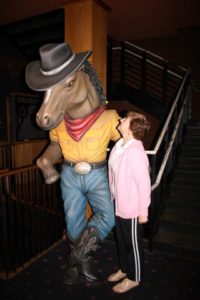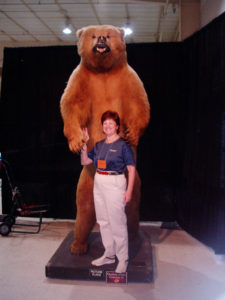Horse Whispering 101

Marsha Mae Marks grew up on a beef, hog and dairy farm in Kankakee, and New Lenox, IL. There she developed a high interest in all things equestrian. Horses were used all over the farm—both draft and back-riders—to put up hay, feed cows in the winter, pull wagons for corn pickers, and take corn out to feed the livestock. She loved Sunday afternoon church picnics when her farm would treat city kids to a taste of farm-life. Working with draft horses, Marsha learned how a working partnership based on loyalty and understanding could exist between a human and an equine. Once she even trained a Holstein steer to saddle. “The animal never put on weight, and so it was not to be slaughtered. I didn’t have a horse, so I used that steer as a horse. He was 7-feet tall and I had to train him to kneel, so my 5-foot 5-inch body could get up on the saddle. I wish I had a picture of him,” she recalled.
Marsha worked with hundreds of riding horses and draft horses from the time she was 13-years old in 1965, until she was hurt in 2009, when she was kicked in the head and neck area by a client’s horse. At that time, she personally had 10 horses and colts.
After her recovery, she came to my farm 9-years years ago, with her recently widowed friend, Judy, her dog Chewy, and Miss Kitty, the only horse she had left after all her stock was sold to pay for her hospital and rehabilitation bills. She chose our farm and Crossville, as a place to live and enjoy the solitude and peace, the easy-to-work-in barn, and 2 acres of sweet-grass paddock. She believes in training by association. When I asked her where she learned so much about training horses, she told me, “My nature is not to force training on a horse, or any four-legged animal. Other trainers would toss a rope and tie a horse to a post and put on the saddle, then try to ride the ‘buck’ out of him. Problem with that is you taught the horse that it is OK to buck with a human on his back. I tried gentle training by voice and association every time a human was on the animal’s back. Everything you do with an animal makes a lasting impression. If the first thing he learns to do is buck, that is what he always thinks of first. I figured I’d teach the horse that the saddle is his friend. To do this safely, I had to break the training of the horse into smaller segments, so he could absorb knowledge without being rushed, and his first memories of his training were pleasant, not fraught with anxiety and stress.”
Marsha explained that stressing a horse shuts down its capacity to learn and retain knowledge, its horse-sense is short-circuited. Body language always plays a large role in the teaching regimen. “If the person is timid and the horse is not, then the horse is in control. However, the opposite is also true, so it is very important to match horse and human, and I did just that for more than 40-years. I learned to identify potential problems and nip them in the bud,” she said. Back through time of natural breeding and exposure to the wild are never truly taken out of them, she told me. So, “In order to have a working partnership you need to understand a horse’s instincts and how to harness them to your mutual benefit,” she explained. Once you understand a horse’s vision of his world, you can adapt and be open to a larger field of vision. Marsha went on to tell us, “A horse sees in a triangular, far-off way. When you’re riding a horse, you see and pay attention to about 20-30 feet ahead of you, whereas a horse sees hundreds of feet down the road, always anticipating potential dangers. A horse in the wild must be aware of his surroundings—where the cougar, wolf or bear might be hiding, or if the animal is in plain, far-off sight. He is not looking at the flowers and 4-leaf clovers as you are. To survive, a horse must take in a long view.” She showed me how her approach to training led her dog, Jesse, to sit with a pointed finger and gentle command. Marsha concluded by saying: “He was under no duress and had a choice; he was not being forced into a seating position. Extrapolate this to training any four-legged, or even two-legged animal. The choice should always be pleasant and rewarding, not threatening.”
The Cat’s Meow
American Press travel news–Feb. 19th, Bob and Barb “On The Road Again”—Cats, Felines, Pussy Cats all have two things in common; fangs and claws, even the cutest ones do. Of course, many more common traits as well, but we’ll explore some of them later.
There are big cats, small cats, and every size, furry feline, with every hair and coat type, in between.
The American Veterinary Medical Association says more than half of U.S. households, or nearly 57 percent, owned a pet at the end of 2016 and most of them own one or more cats.. Nearly one in four households nationwide, or 38 percent, owned one or more dogs, which the association says is the highest estimated rate of dog ownership since 1982, when it began measuring ownership.
One of the most common pets in the world, cats are known to be the most independent animal pets. If you are a cat lover, you’d be interested to know how many cat breeds there are in the world. Read on you’ll find out! Imagine the average cat can spend two thirds of the day by sleeping. A cat who is 10 years old only stayed awake for 3.3 years in its lifetime.
We accept these intriguing animals as pets, however some of the Asian countries consider them as food. In fact, cat meat is very popular in most of the Asian countries. The sad fact is China alone among the far-eastern nations, consumes more than 4 million cats in a year. There are animal lovers that try to do something about this, but the government of China still allows it.
Going back in history, the Papal declared that the cats are evil during the Spanish Inquisition and untold numbers of cats were slaughtered in Europe! Sometimes the is such thing as “cats revenge” After Europe murdered so many of their cats, and as the amount of the cats dramatically decreased, the mice and rat population increased in about the same proportion. As a result, the great pestilence (Black Plague) occurred, and millions of people lost their lives during this period. On the brighter side; bet you didn’t know that we sent a cat to space? The first cat that went to space went there in 1963. Her name was Felicette, a French cat. She came back to earth without any problem.
Although we have fed them at our homes for thousands of years, cats still have plenty of wild instincts. Unlike the dog, cats lower their head while they are chasing their prey. Female cats usually use their left paws more, while most of the male cats prefer to use their right paws more.
Many people are allergic to cats (my wife Barb is one of them). After much research, and speaking to specialists in allergies, it appears that cats dried airborne saliva from their fur- cleaning tongue is the culprit. Its breathed in by everyone in contact in their homes, and everywhere cats abide, and causes allergic reactions to one in ten people.
You have probably heard many different vocalizations coming from your cat. But we can easily say that you have not heard all their voices, even though you are living with your cat for years. They have more than a hundred different vocalizations, while this amount is only limited to about ten in dogs. And that’s enough for me!!
Like dogs, cats don’t have sweat glands in their bodies. They sweat through their paws.
Cats purr and meow, and rub their scent glands all over any part of your legs. People think they love them for this. Not so fast! Cats love other cats, that’s it, except for them bonding with you for food and comfort.
Besides sleeping so much of the day and night, cats spend another third of their time by cleaning themselves, or each other.
According to International Progressive Cat Breeders Alliance (IPCBA), there are 73 different cat breeds in the world with many variations in their personalities and temperament. However, there are some cat breeds which are not recognized as a breed yet, so more breeds will come into being as well.
A few things that are quite negative about cats: When left to their own instincts they not only kill rodents, but also birds. Its their nature to pursue anything that moves and tries to escape their claws and fangs. What I don’t like is that they do their business inside, even if its inside a box of cat litter there are odors. Cats also can transmit disease to humans. I do not kiss cats or dogs for this possibility. My doctor daughter-in-law spent time in the hospital herself a victim of Scratch-Fever.
So, remember; of course love them all, they are great companions even with their faults.








